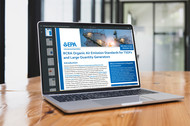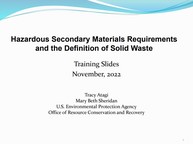|
|
January 19, 2023
The purpose of this newsletter is to provide interested parties with updates about the federal solid and hazardous waste programs, such as information about rulemakings, upcoming webinars, guidance documents, open comment periods, and other related communications.
|
|
EPA Holds Engagement Meetings for Open Burn/Open Detonation (OB/OD) Detonation of Waste Explosives
On December 5th, 2022, EPA hosted a public engagement webinar about OB/OD. During this webinar, EPA presented and solicited input on specific approaches under consideration for its forthcoming proposed rulemaking revising the standards for the OB/OD of waste explosives.
|
|
EPA Updates Resource Conservation and Recovery Act (RCRA) Organic Air Emission Standards Fact Sheet
|
In December, EPA updated a 1998 fact sheet on RCRA Organic Air Emission Standards for Treatment, Storage and Disposal Facilities (TSDFs) and Generators.
These updates describe the requirements of the RCRA organic air emission standards contained in Title 40 of the Code of Federal Regulations, parts 264/265, subparts AA, BB, and CC for hazardous waste TSDFs and generators of hazardous waste.
Visit our webpage to learn more about RCRA Organic Air Emission Standards for TSDFs and Generators and access this new resource.
|
|
 |
|
|
EPA Publishes Training Slides about the Hazardous Secondary Materials Requirements and the Definition of Solid Waste

Have you ever wondered why it matters if a hazardous secondary material is a solid waste? Or what you need to know to determine if something is a solid waste for purposes of RCRA hazardous waste regulation? The amount of hazardous waste regulation depends on the type of material and how it is being managed. Often, hazardous secondary materials being recycled are subject to less or no regulation. To find out more, check out our training slides to learn about the hazardous secondary materials requirements and the definition of solid waste.
|
|
|
EPA Proposes to Deny Petition to Classify Discarded Polyvinyl Chloride (PVC) as Hazardous Waste
On January 12, 2023, EPA responded to a rulemaking petition from the Center for Biological Diversity requesting that discarded PVC be listed as a hazardous waste under RCRA. After careful consideration, we are tentatively denying the petition because the petitioners do not provide sufficient evidence that regulation of discarded PVC under RCRA is warranted. We will accept comments on this proposal for 30 days through Regulations.gov. Read through the proposed denial for more information.
|
|
EPA Posts a Template for Documentation of Legitimate Recycling
EPA created a template that persons recycling hazardous secondary materials may choose to use to document their legitimacy determinations. Persons performing the recycling under the generator-controlled exclusion of Title 40 of the Code of Federal Regulations in section 261.4(a)(23) must maintain documentation of their legitimacy determinations on-site. Documentation needs to include a written description of how the recycling meets the legitimate recycling factors. This template can also be used to document a claim of legitimate recycling under any other recycling exclusion or exemption. Check out the template.
|
|
Join Us for the January e-Manifest Webinar
|
|
EPA Adds New Member to the Utility Solid Waste Activities Group (USWAG) Nationwide Risk-Based PCB Remediation Waste Disposal Approval
In December 2022, EPA added one new USWAG member, Pacific Gas and Electric Company, to their existing risk-based disposal approval. This approval allows for the disposal of less than 50 parts per million polychlorinated biphenyls remediation waste under the Toxic Substances Control Act (TSCA) in certain non-TSCA approved disposal facilities, such as municipal solid waste landfills, non-hazardous waste landfills, and hazardous waste landfills. The updated final approval also contains minor changes. Access the approval and learn more on our website.
|
|
|
EPA developed a fact sheet to help owners, operators, contractors, and regulators implement Greener Cleanup Best Management Practices (BMPs) at PCB cleanup sites. The fact sheet provides green remediation best management practices, feasibility case studies, and a toolkit, including a list of common BMPs used at PCB cleanup sites. Check out the fact sheet.
|
|
|
EPA is making $40M in funding available to help build and transform solid waste infrastructure, manage materials to achieve a circular economy, reduce greenhouse gas emissions, and create cleaner, resilient, and healthier communities. EPA released a new funding opportunity for tribes and intertribal consortia under the Solid Waste Infrastructure for Recycling grant program, which is funded by the historic Bipartisan Infrastructure Law. Register for these webinars.
SWIFR Grants for Tribes and Intertribal Consortia ($40,000,000): Funding for projects that improve materials management and infrastructure, including collection, transport, systems, and processes related to post-use materials that can be recovered, reused, recycled, repaired, refurbished, or composted. Applications for funding are due April 4, 2023.
- Overview of request for application, eligible entities, evaluation criteria, application process, and answer questions (same presentations)
-
January 19, 2023 @ 3:00pm – 4:00pm (EST)
-
January 25, 2023 @ 4:00pm – 5:00pm (EST)
- Review procurement, subawards, and answer questions (same presentations)
-
February 1, 2023 @ 1:00pm – 2:00pm (EST)
-
February 7, 2023 @ 4:00pm – 5:00pm (EST)
Learn more about this funding opportunity at EPA’s webpage: https://www.epa.gov/rcra/grants-tribes-and-intertribal-consortia
Stay connected to receive notifications about this grant opportunity and when registration for the webinars is available. Let us know if you need accommodations by email.
|
|
EPA is Accepting Applications for State Coal Combustion Residuals Grants
On January 18, 2023, EPA began accepting applications for the $7,000,000 in State and Tribal Assistance Grant funds authorized by Congress to aid states in the development and implementation of state programs for the control of coal combustion residuals. EPA’s goal is to incentivize and reward states for implementing their own coal combustion residuals programs. States can now submit their applications through Grants.gov for these grants. The deadline to submit applications is March 21, 2023.
|
|
|
On January 18, EPA published a Federal Register notice that announced a public, virtual meeting of the Hazardous Waste Electronic Manifest System (e-Manifest) Advisory Board. This meeting will be held February 28–March 2, 2023, from 10:00 a.m. to approximately 5:00 p.m. (ET).
|
|
|
|
|